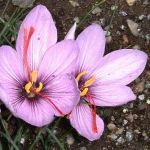| Common Name: |
Saffron Crocus |
| Botanical Name: |
Crocus sativus |
| Genus: |
Crocus |
| Family: |
Iridaceae |
| Native Location: |
Mediterranean |
| Cultivation: |
Well-drained, light, rich soil, pH7, in full sun. For optimum flowering, plant corms 15cm (6in) deep and 10cm (4in) apart. Crocus sativus grows, but fails to flower, in areas with wet, cloudy summers. |
| Propagation: |
By offsets removed from the parent corm in late spring. |
| Harvest: |
Flowers are picked when open and the styles removed for drying. Saffron does not store well and should be used within a year of harvesting. |
| Variations: |
Cashmirianus
Is a high-yielding strain from Kashmir, with large corms and violet-blue flowers with deep orange styles. |
| Height: |
10cm (4in) |
| Width: |
10cm (4in) |
| Hardiness: |
Z4-8 |
| Parts Used: |
Styles (fan hong hua) |
| Properties: |
A pungent, bitter-sweet herb that improves digestion, increases perspiration, stimulates the circulation and menstruation, and reduces high blood pressure. |
| Medicinal Uses: |
Internally, in Chinese traditional medicine, for "stagnant liver energy", as in depression and menstrual disorders. Contraindicated during pregnancy. |
| Culinary Uses: |
Used as a flavoring and colorant for cakes, cookies, puddings, eastern sweetmeats, and sauces; in rice dishes, such as paella (Spain), risotto milanese (Italy), and biryani (India); in fish stews, such as zarzuela (Spain) and bouillabaisse (France). |
| Economic Uses: |
A flavoring and colorant in liqueurs. |
| Bibliography: |
Encyclopedia of Herbs by Deni Brown Copyright © 1995, 2001 Dorling Kindersley Limited Pp 183-184 |

